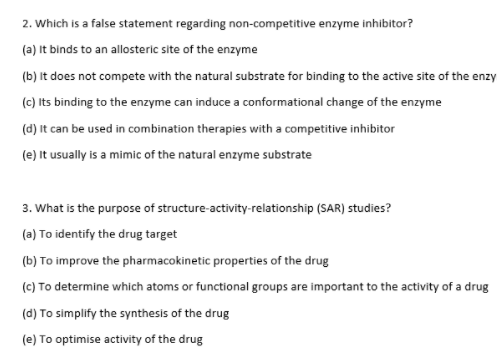2. Which is a false statement regarding non-competitive enzyme inhibitor? (a) It binds to an allosteric site of the enzyme (b) It does not compete with the natural substrate for binding to the active site of the enzy (c) Its binding to the enzyme can induce a conformational change of the enzyme (d) It can be used in combination therapies with a competitive inhibitor (e) It usually is a mimic of the natural enzyme substrate 3. What is the purpose of structure-activity-relationship (SAR) studies? (a) To identify the drug target (b) To improve the pharmacokinetic properties of the drug (c) To determine which atoms or functional groups are important to the activity of a drug (d) To simplify the synthesis of the drug
2. Which is a false statement regarding non-competitive enzyme inhibitor? (a) It binds to an allosteric site of the enzyme (b) It does not compete with the natural substrate for binding to the active site of the enzy (c) Its binding to the enzyme can induce a conformational change of the enzyme (d) It can be used in combination therapies with a competitive inhibitor (e) It usually is a mimic of the natural enzyme substrate 3. What is the purpose of structure-activity-relationship (SAR) studies? (a) To identify the drug target (b) To improve the pharmacokinetic properties of the drug (c) To determine which atoms or functional groups are important to the activity of a drug (d) To simplify the synthesis of the drug
Introductory Chemistry: An Active Learning Approach
6th Edition
ISBN:9781305079250
Author:Mark S. Cracolice, Ed Peters
Publisher:Mark S. Cracolice, Ed Peters
Chapter22: Biochemistry
Section: Chapter Questions
Problem 22.3TC
Related questions
Question

Transcribed Image Text:2. Which is a false statement regarding non-competitive enzyme inhibitor?
(a) It binds to an allosteric site of the enzyme
(b) It does not compete with the natural substrate for binding to the active site of the enzy
(c) Its binding to the enzyme can induce a conformational change of the enzyme
(d) It can be used in combination therapies with a competitive inhibitor
(e) It usually is a mimic of the natural enzyme substrate
3. What is the purpose of structure-activity-relationship (SAR) studies?
(a) To identify the drug target
(b) To improve the pharmacokinetic properties of the drug
(c) To determine which atoms or functional groups are important to the activity of a drug
(d) To simplify the synthesis of the drug
(e) To optimise activity of the drug
Expert Solution
This question has been solved!
Explore an expertly crafted, step-by-step solution for a thorough understanding of key concepts.
This is a popular solution!
Trending now
This is a popular solution!
Step by step
Solved in 2 steps

Knowledge Booster
Learn more about
Need a deep-dive on the concept behind this application? Look no further. Learn more about this topic, chemistry and related others by exploring similar questions and additional content below.Recommended textbooks for you

Introductory Chemistry: An Active Learning Approa…
Chemistry
ISBN:
9781305079250
Author:
Mark S. Cracolice, Ed Peters
Publisher:
Cengage Learning


Chemistry for Today: General, Organic, and Bioche…
Chemistry
ISBN:
9781305960060
Author:
Spencer L. Seager, Michael R. Slabaugh, Maren S. Hansen
Publisher:
Cengage Learning

Introductory Chemistry: An Active Learning Approa…
Chemistry
ISBN:
9781305079250
Author:
Mark S. Cracolice, Ed Peters
Publisher:
Cengage Learning


Chemistry for Today: General, Organic, and Bioche…
Chemistry
ISBN:
9781305960060
Author:
Spencer L. Seager, Michael R. Slabaugh, Maren S. Hansen
Publisher:
Cengage Learning

Organic And Biological Chemistry
Chemistry
ISBN:
9781305081079
Author:
STOKER, H. Stephen (howard Stephen)
Publisher:
Cengage Learning,

General, Organic, and Biological Chemistry
Chemistry
ISBN:
9781285853918
Author:
H. Stephen Stoker
Publisher:
Cengage Learning
